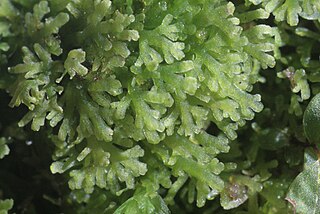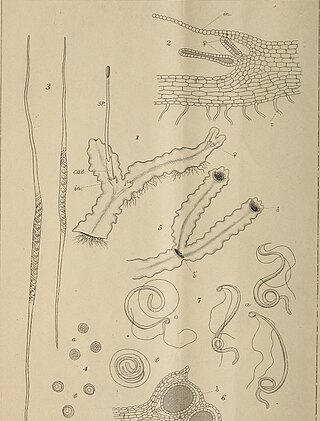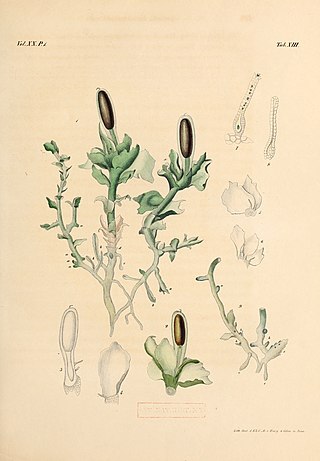
The Marchantiophyta are a division of non-vascular land plants commonly referred to as hepatics or liverworts. Like mosses and hornworts, they have a gametophyte-dominant life cycle, in which cells of the plant carry only a single set of genetic information.

Marchantiales is an order of thallose liverworts that includes species like Marchantia polymorpha, a widespread plant often found beside rivers, and Lunularia cruciata, a common and often troublesome weed in moist, temperate gardens and greenhouses.

Metzgeriales is an order of liverworts. The group is sometimes called the simple thalloid liverworts: "thalloid" because the members lack structures resembling stems or leaves, and "simple" because their tissues are thin and relatively undifferentiated. All species in the order have a small gametophyte stage and a smaller, relatively short-lived, spore-bearing stage. Although these plants are almost entirely restricted to regions with high humidity or readily available moisture, the group as a whole is widely distributed, and occurs on every continent except Antarctica.

Lepidoziaceae is a family of leafy liverworts. It is a group of small plants that are widely distributed.

Cavicularia densa is the only species in the liverwort genus Cavicularia. The species was first described in 1897 by Franz Stephani, and is endemic to Japan, where it grows on fine moist soil.

Aneuraceae is a family of thallose liverworts in the order Metzgeriales. Most species are very small with narrow, branching thalli.
Schistochila vitreocincta is a species of liverwort in the family Schistochilaceae. Under its synonym Perssoniella vitreocincta it was the only species in the monotypic genus Perssoniella and family Perssoniellaceae. It is endemic to New Caledonia. Its natural habitat is subtropical or tropical dry forests.

Herbertaceae is a family of liverworts. The family consists of the genera Herbertus, Schisma and Triandrophyllum. The genus HerpocladiumMitten, 1873 was later merged into the genus Herbertus.

Blasiales is an order of liverworts with a single living family and two species. The order has traditionally been classified among the Metzgeriales, but molecular cladistics suggests a placement at the base of the Marchantiopsida.
Colura is a genus of epiphytic type of liverworts and consists of approximately 80-90 species, that are distributed generally in the tropics.
Cryptothallus is a previously recognized genus of liverworts in the family Aneuraceae. The plants are small, and are white to pale green as a result of lacking chlorophyll. This feature led to the creation of a separate genus. The morphology of species assigned to Cryptothallus is very similar to that of Aneura. As a result, Karen Renzaglia in 1982 suggested that the only species then placed in the genus, Cryptothallus mirabilis, may be considered "merely as an achlorophyllous species of Aneura." Wickett and Goffinet argued the same position on the basis of sequences of nuclear, mitochondrial, and plastid DNA, and moved Cryptothallus mirabilis to Aneura. A 2010 molecular phylogenetic study confirmed the position of Cryptothallus within Aneura. This was accepted in the 2016 world checklist of hornworts and liverworts.

Makinoa crispata is the only species of liverwort in the genus Makinoa and family Makinoaceae. The genus Verdoornia was formerly included in this family, but has been transferred to the family Aneuraceae on the basis of recent cladistic analysis of genetic sequences.
Vetaforma is a genus of liverworts found only in Argentina and Chile, and contains a single species Vetaforma dusenii. It is classified in the order Jungermanniales. It was placed as the only member of the family Vetaformaceae within that order, but this family has been merged into the family Lepicoleaceae based on morphological and genetic data. The genus name was originally published in 1960, but this publication was invalid under Article 36.1 of the International Code of Nomenclature for algae, fungi, and plants. The single species was first described in 1900 as Lepidozia dusenii and transferred to Vetaforma in 1962.
Neotrichocoleaceae is a family of liverworts in order Ptilidiales. It is closely related to the genera Ptilidium and Herzogianthus.
Acrobolbus epiphytus is a liverwort species in the genus Acrobolbus. It occurs in New Zealand.

Cephaloziaceae is a family of liverworts.

Haplomitrium is a genus of liverworts.
Trichocolea is a genus of liverworts belonging to the family Trichocoleaceae.

Pleurozia purpurea is a species of thalloid liverwort, notable for its red to purple colour. Common names of the species include purple-worm liverwort and purple spoonwort.

Asterella palmeri, also known as Palmer's asterella, is a species of liverwort native to southwestern North America that can be found growing between roughly 30° and 40° north latitude. The plant is found in the U.S. state of California as far north as Redding, and in the Mexican state of Baja California as far south as Punta Baja, as well as in the northwestern corner of U.S. state of New Mexico. According to California bryologists William T. Doyle and Raymond E. Stotler, Palmer's asterella is typically found around chaparral, conifers, and in oak woodland in "exposed to lightly shaded summer-dry soil; usually on gentle to steep slopes." This liverwort is usually found below 950 metres (3,120 ft) elevation, but in the southern Sierra Nevada can be found at up to 1,250 metres (4,100 ft) above sea level.












